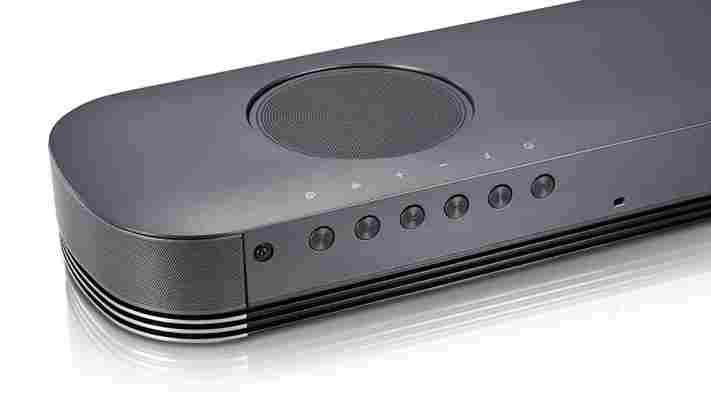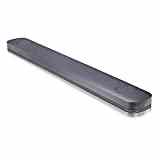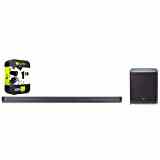Dolby’s Atmos surround-sound technology has progressed gradually from niche tickbox for home-theatre nuts to a reasonably well-known and desirable feature; that’s largely thanks to co-branding schemes with smartphone, laptop and games console manufacturers. Atmos’ heartland, however, remains in the world of home cinema and where products like the LG SJ9 are hoping to extend its reach further.
READ NEXT: The best soundbars to buy in 2018
LG SJ9 review: What you need to know
The LG SJ9 still isn’t an enthusiast product, although it is priced like one. It’s a standalone Atmos-enabled soundbar with a subwoofer and no rear speakers, relying on a pair of upward-firing drivers to give the sound the extra height that Atmos is best known for.
It can’t recreate an enveloping surround audio effect, but it is an otherwise reasonably well-equipped soundbar and a well-designed one at that. Width-wise, it’s best suited to 55in TVs and above – anything smaller and it will stick out awkwardly at the sides. However, you don’t need to worry too much about height as the SJ9 is remarkably low profile. It should sit comfortably in from of most modern TVs without impinging on your view of the screen, unlike some of its rivals (Samsung HW-K850, I’m looking at you).

Other key features include Bluetooth support for the connection of mobile devices, Wi-Fi connectivity with Spotify Connect and Google Cast support, high-resolution audio up to 192kHz/24-bit, and multiroom audio using LG’s MusicFlow system. The subwoofer the system comes with is wireless, although you will need to plug it into the mains.
As for surround sound-standards, the SJ9 can decode up to Dolby True HD, but DTS support is limited to regular DTS Digital Surround, not the lossless DTS-HD Master Audio or DTS:X.
LG SJ9 review: Price and competition
At a price of £649, the LG SJ9 is priced to compete directly with the likes of the Atmos-enabled Samsung HW-K850 , which is the gold standard for this type of soundbar. You can pick up one of these Samsung soundbars for around £799, while the Philips B8/12 SkyQuake – another direct competitor – is around £750 so the LG looks comparatively good value.
If Atmos isn’t of interest, you can pick up a set that includes rear speakers for less. Or you can save even more and buy a decent standalone soundbar without Atmos. The Samsung HW-MS550 is a mere £220 right now and an absolute bargain and the Samsung HW-MS650 is also a good buy at around £380.



LG SJ9 review: Connectivity and sound quality
Although wireless connectivity is reasonably good on the LG SJ9, as detailed above, physical connectivity falls a little short. Limited connectivity isn’t really a shock on a soundbar, but what’s surprising is exactly how limited the SJ9 is. There’s only one HDMI input here and one ARC-enabled output, which doesn’t give you much flexibility. Note, too, that the ARC channel doesn’t support Atmos audio.
That’s not to say there’s no support for extra devices. With 3.5mm and optical S/PDIF inputs available, you can hook up other sources without having to fiddle around swapping cables, but for this sort of money I’d expect more – a whole lot more.
Once you’ve decided which device to hook up, the SJ9 is at least reasonably easy to use. The remote control doesn’t look much, but it’s straightforward to get to grips with. All the buttons are replicated on the rear towards the right-hand side, so if you misplace the remote control, you can still turn the soundbar on and off, adjust the volume and switch sources fairly easily.
A white LED matrix display displays the volume level and which source you’re using or which mode you’re using, although you won’t need to fiddle with the settings too much since you’ll probably want to stick to Standard. I found the rest of the presets added little to the default setting. As usual, LG’s automatic audio – which is supposed to analyse the sound and adapt it to suit – was unconvincing.
Alas, whichever setting you choose, the LG SJ9 is pretty uninspiring. I’ve no issue with scale or volume. The bar delivers a solid 300W of amplification driving seven speakers in the soundbar and 200W driving the wireless subwoofer. At no point did I find it particularly engaging, however.
No matter where I positioned the sub in my lounge, the bass, in particular, lacked authority, grip and definition, with explosions subsiding into loose rumbling. The Samsung HW-K950’s bass also lacks definition, but it’s much more exciting to listen to, creating a wider soundstage and a much better separation of instruments.
With the Dolby Atmos test disc in the tray of my Atmos-enabled source – an Xbox One X – I fired up the various demos and found myself disappointed. With the Samsung HW-K950, there’s a palpable sense of vertical height to the sound: rain seems to come from directly above in the rainforest demo, and the Boeing 747 sounds like it’s actually flying low over your house.
The LG SJ9 is simply not as involving, with all the sound appearing to emanate from a plane in front of you. It might work better in a room with higher or lower ceilings than my living room (2.4m); either way, though, there’s no adjustment you can make yourself to the amount of volume these Atmos drivers kick out.
Switching to regular Dolby and DTS soundtracks, the SJ9 produces a confident performance that’s comfortable to listen to. Voices are clear, audible and locked in the centre, and there are no technical problems. However, the width and surround effect isn’t as convincing as I’d like for this sort of cash.
LG SJ9 review: Verdict
The LG SJ9 is not a bad product. If you were to tell me the price was between £400 and £500, I’d be impressed. It’s loud and authoritative, better value than the Bose SoundTouch 300 and wireless connectivity is pretty decent.
However, for £649, it doesn’t offer enough. Only one HDMI input is, frankly, mean, the SJ9 doesn’t support DTS-HD Master Audio, and the sound quality is not as good as it should be for this sort of cash. The Samsung HW-K850 delivers a far more convincing height effect and better overall sound quality. Even better, save money by buying a non-Atmos soundbar or getting a non-wireless surround-sound system with rear speakers.











